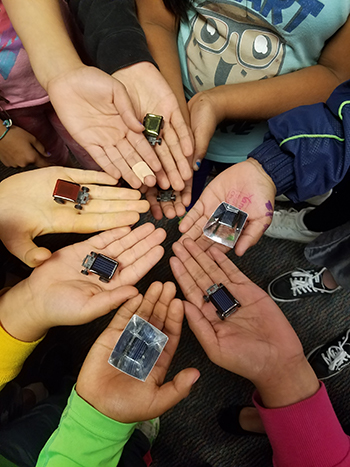By Betsy Fradd, WSU Extension | June 2016

It could be that veggie burger they had for lunch, the shower taken the night before, or the fuel used in the family truck that helps students learn about energy. For the third through eighth graders sitting in the classroom, each scenario is an opportunity to learn about different types of energy and the role it plays in their lives.
“Our energy portfolio future is dependent on the young minds that will be entering into the job force in 10+ years, and by teaching about general energy now, they are being involved in the energy discussion,” said Sarah Lane, WSU Extension Energy Intern and member of the AHB Extension team. “General energy education is important to AHB because for individuals to understand the mission and prospect of biofuels, it is necessary for there to be an understanding of how energy is used in our daily lives.”
Lane is taking her one-hour presentation on the road to schools in Snohomish, South Skagit, and North King counties in Washington State. This spring she has visited 700 students, covering topics including energy basics, water and carbon cycles, food chains, renewables, alternative energy, and forms of human energy. An interactive activity with tiny, one-inch solar cars allows students to immediately see the results of light energy.

“The students find the solar car activity to be the most useful because it gives them a chance to touch, experiment, and put their energy knowledge to work,” said Lane. “After they have listened and participated with me during the initial presentation, they are very excited to really see if light energy can power a solar car toy and propel it down the racetrack.”
Short pre-and post-tests show students’ energy awareness. Questions focus on whether energy is limited, its transferability from one system to another, and whether it can be created or destroyed. Students are also asked which types of energy are renewable, and if they know the main source of power used in their county with wind, coal, biomass, and hydroelectric given as examples.
Lane is encouraged by the young learners. “At the end of the lesson, I ask them what we can do to use less energy, and it is exciting to hear kids say they can turn off the computer when they are done, walk or bike instead of asking their parents to drive somewhere, or take shorter showers. One student decided he wants to develop a machine that can go at the bottom of the bathtub and act as a turbine to capture the gravitational energy of the water falling down the pipes. He thought that energy could be used to reheat the water in the shower. I am constantly amazed at the creative ideas the students have about energy.”
